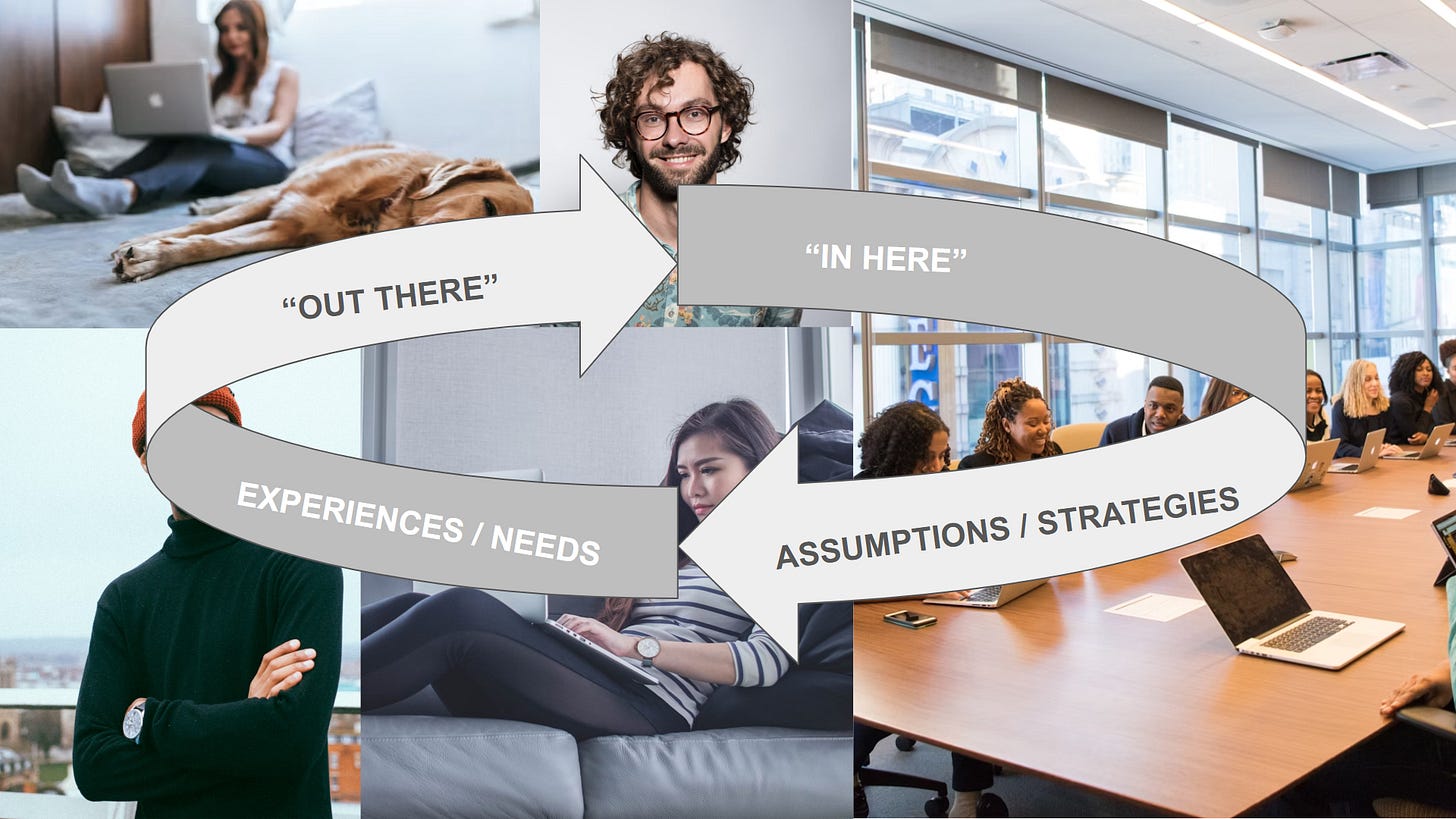Unlocking Breakthrough Learning & Innovation Through Team-Based Ethnography
There is nothing like being there.
To understand. To shift thinking.
To see with new eyes.
The Spark
Twenty-plus years ago, I had just accepted a position at a large financial services institution as its first user research manager—on one condition:
I could take a designer and a business person on the road for three weeks of in-home research with customers focused on how they manage their finances.
You can read more about that project in the case studies section of Ubuntu Culture Company’s website, but here’s the bottom line:
Those three weeks sparked insights the bank drew on for the next six years.
In the short term, Product realized their approach to budgeting tools was out of sync with people’s lives. In the long term, we learned that keeping design tools—like personas, task models, and journey maps—alive and updated ensured we stayed connected to what mattered.
Real Insight Requires Reflection
In the age of generative AI, behavioral dashboards, and a flood of digital content, it’s tempting to believe that human experience can be algorithmically inferred.
But real insight—transformative, gut-level, world-shifting knowing—doesn’t come from data alone.
It comes from:
Experiential and reflective immersion
Deep hanging out
Witnessing life unfold in its natural environment
Listening with openness and humility
Revealing our hidden assumptions
That’s the power of team-based ethnography.
Why It Works
Ethnography—the foundational method of anthropology—is about understanding human behavior in context.
It’s not about abstract personas or focus group quotes.
It’s about being with people, in their world, seeing how they move through it.
When small, cross-functional teams engage in this work—not as outside observers, but as intentional learners—the impact is catalytic.
Team-based ethnography shifts the question from
“What do people want from us?” to
“What does the world want from us—and who do we need to become?”
From Insight to Innovation
When employees step into the homes, workplaces, and lives of those they serve, and when they observe, listen, and reflect together—they learn more than just where their product fits in.
They often rediscover purpose and reconnect with the deeper meaning of their work.
“My understanding is so much broader and deeper after just one session. We thought we knew what customers wanted. But being there changed everything. There is so much value that is unlocked when we really listen and pay attention to our own assumptions about what we think we know.”
—Team Member, Ethnographic Research Project
This is not market research. It’s not a tool for validation.
It’s a practice of reflective sensemaking—a way to surface blind spots, reveal and challenge deeply held assumptions, and open space for new possibilities and paths forward.
Dr. Barbara Perry, a cultural anthropologist and cherished mentor, calls ethnographic inquiry “a reflective practice of seeing, feeling, and understanding across boundaries.” It’s as much about internal transformation as external discovery. And it’s essential for innovating in times of perpetual upheaval where everything around us is in flux.
As I’ve written before, in times of constant change, the only thing we can control is how much and how fast we learn and team-based ethnography helps us learn holistically—with our head, heart, and spirit.
Intentional Learning Matters
New learning and innovation research, from Dr. Amy Edmondson and colleagues, summarized in the Harvard Business Review confirms what team-based ethnographers have long known:
Innovation thrives not through continuous information intake—but through cycles of learning and reflection that are intentionally sequenced.
Teams that try to do everything at once—fieldwork, reflection, idea generation—often burn out or stall.
Team-based ethnography is designed to naturally follow this rhythm:
First, immersion in the real world
Then, spacious reflection and meaning-making
And finally, translation into action and strategy
Like music, learning needs both tension and release to come alive.
How I Help You Bring This to Life
A team-based ethnography engagement typically unfolds over 2–3 months and follows this arc:
Define the Inquiry
Frame the strategic question and identify the people whose voices matter most.Name Your Assumptions
Articulate what you think you know—and what you’re ready to unlearn.Prepare the Team
Train a small, internal team in the mindsets and methods of ethnographic research.Fieldwork
Conduct immersive interviews and observations in real-world environments.Meaning-Making & Mindset-Shifting
Look for patterns, tensions, surprises. Revisit your assumptions. Reflect together.Codify & Share
Translate insights into usable artifacts—stories, personas, journey maps, experience principles.
The outcome isn’t just insight. It’s transformation.
You get shared understanding between the world “out there” and your assumptions “in here.”
What Changes
Here’s what you can expect when your team does this work together:
Breakthrough perspective shifts that spark innovation
Actionable insights grounded in real life—not guesses
Cross-silo collaboration that builds trust and organizational memory
Clarity on what matters to the people you serve
Reconnection to purpose and mission
Reduced risk through alignment with lived experience
And maybe most importantly:
You start seeing yourselves—and the purpose of your work—with new, sharper, more focused eyes.
Learning That Sticks
Organizational learning requires:
Emotional engagement
Shared reflection
A willingness to be changed by what we learn
Team-based ethnography cultivates all three.
Because when we learn together—
when we sit with complexity together—
when we listen with open hearts—
something shifts.Not just in what we know,
but in who we become.We become people who care, connect, and create—together.
Ready to unlock the learning that sparks innovation?
Let’s talk about how team-based ethnography can transform your team’s perspective and your business outcomes.
Schedule 30 minutes or reach out: robin@ubuntuculturecompany.com
Let’s dive beneath the surface and into the soul of the matter.



This makes so much sense that it's amazing that it's not common practice. Taken into my world of the future of work it also speaks to the gap between companies not focusing on DEI or flexibility creating a gap with their customers.
Robin — I cannot remember the last time I read a more insightful or more beautifully written article. This should be required reading for researchers, product teams, and executives alike.